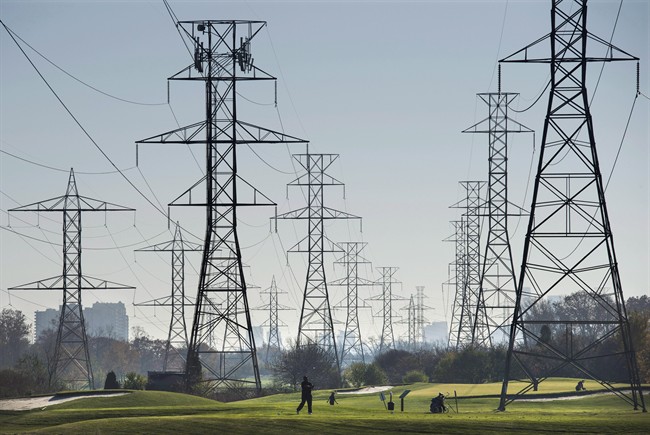The Ontario Clean Air Alliance says Premier Kathleen Wynne can help solve Ontario’s electricity affordability problems by cancelling the planned $12-billion refurbishment of the province’s Darlington nuclear facility and purchasing cheaper hydroelectric power from Quebec.

The organization is also calling on the province to scrap plans for extending the life of the Pickering nuclear facility and to begin its immediate decommissioning.
READ MORE: Hydro One leaves family of 6 without electricity for months
In a statement obtained by Global News, Jack Gibbons, chair of the Ontario Clean Air Alliance, says Wynne’s decision to proceed with nuclear refurbishment “unnecessarily” increases electricity bills.
“Premier Wynne’s decision to prop up aging nuclear plants has nothing to do with keeping the price of electricity down for you. In fact, her nuclear plans are going to unnecessarily increase your bills,” Gibbons said.
The increases Gibbons is referring to relate to a recent rate-increase proposal put forward by Ontario Power Generation, the provincially owned company responsible for managing the Darlington and Pickering nuclear facilities.
The application asks the Ontario Energy Board to approve a 66 per cent rate increase for nuclear power generated at the two facilities over the next five years. If approved, the price the government pays OPG for nuclear power would increase from the current rate of 5.9 cents per kilowatt hour (kWh) to roughly 10 cents per kWh by 2021.
The Ontario Clean Air Alliance is an environmental group that worked to help phase out coal in Ontario and favours renewables such as hydroelectric power, wind and solar over the use of fossil fuels and nuclear-generated power.
WATCH: Hydro rates in Ontario keep going up, making many families decide between foods and heat. Mike Drolet spoke with one today so deep in debt they’re desperate for help.

While OPG’s proposal is limited to the next five years, the application also references plans to extend the rise in prices at a rate of 11 per cent per year between 2016 and 2026 as a way of recovering the cost of refurbishment.
If approved, these additional increases would see the per kilowatt-hour price of nuclear power generated by OPG – until now one of the cheapest forms of electricity produced in Ontario – rise from 9.9 cents in 2021 to nearly 17 cents by 2026 – a 185 per cent increase over the 2016 price.
A better way forward, says Gibbons, would be to forget nuclear refurbishment altogether and agree to purchase more electricity from Quebec.
Buying more from Quebec
In October, Wynne and Couillard announced plans for Ontario to purchase two terawatt hours (tWh) of electricity from Quebec each year – enough power to run nearly 230,000 Ontario homes.
But Gibbons thinks this amount is nowhere near enough. He says Ontario needs to abandon its costly addiction to nuclear power in exchange for strengthening ties with Quebec.
READ MORE: Kingston Hydro cuts off single mom who chose groceries over utility bill
WATCH: An anonymous donor has paid off the entire outstanding hydro bill of a Kingston, Ont. couple whose power was cut off by Hydro One in August. Marianne Dimain reports.

Quebec’s clean energy surplus
So exactly how much clean energy does Quebec have?
Quebec produces roughly 99 per cent of its electricity from hydroelectric dams and is among the largest producers of clean energy in the world.
At present, Quebec has the capacity to produce roughly 200 tWh of electricity each year – enough to power nearly 23 million homes.
The province exports approximately 15 per cent of this total to places like New York, Massachusetts, New Brunswick and Ontario, but Gibbons says this amount could more than double from 31 to 62 tWh a year if Quebec were to make improvements to its energy system’s efficiency.
Gibbons cites a report from Montreal’s HEC school of energy management which says such measures would not only be cost-efficient – meaning they’d save Quebec ratepayers money – but they’d also free up as much as 31 tWh of electricity for export.
This point is further illustrated by a 2014 report prepared for the Quebec Ministry of Energy and natural resources which states that upward of 90 per cent of Quebec’s energy exports are sold on the open market, without any long-term contracts, at an average price of three cents per kWh – or roughly 40 per cent less than what Ontario has agreed to pay for Quebec’s hydro power.
WATCH: Hydro rates in Ontario have spiraled out of control. Leaving many Ontarians to choose between food and heat. Mike Drolet has the debate and what the government plans to do about it.

Ministry of Energy responds
Ontario Energy Minister Glenn Thibeault says the Clean Air Alliance is misguided if it thinks energy imports from Quebec alone can meet Ontario’s need for clean, reliable electricity.
“The Clean Air Alliance is wrong to suggest all of this could simply be replaced with electricity imports from Quebec,” said Thibeault. “Over the past decade, Ontario completely phased out dirty coal as a source of electricity. This is the largest climate change initiative in North America, and our safe, reliable nuclear energy supply was part of what made it possible.”
Thibeault also says that while costs of the Darlington rebuild are significant, the planning process and job creation aspects of the project will ensure it’s done right and that Ontarians will benefit from the project as a whole.
“Planning for these projects has taken five years, even building a full-scale mock reactor to fine tune the refurbishment process,” said Thibeault. “The Darlington refurbishment project alone will create up to 12,000 jobs in Ontario, and provide almost $15 billion in economic benefits.”
And while the large-scale import of electricity is at least theoretically possible, Thibeault says differences in the provinces’ energy needs and capacity make it highly impractical – a statement echoed by OPG.
“Imports on the scale the Clean Air Alliance suggests would require billions of dollars in costly system upgrades from both provinces and still would not provide the sort of reliable, home-grown electricity that we get from nuclear,” Thibeault said.
What to do with nuclear
For now, Ontario is moving full steam ahead with plans to refurbish the Darlington nuclear plant and extend the life of the aging Pickering facility.
The costs associated with these rebuilds will be passed on to Ontario ratepayers through the province’s Global Adjustment fee and will equal roughly $1.05 more per month on average electricity bills over the next decade.
But as Gibbons points out, this is dependant upon planned refurbishments coming on time and on budget – something Gibbons says no major nuclear project in Ontario’s history has ever accomplished.
READ MORE: Ontario electricity rates will remain unchanged, first time in nearly a decade
Instead of rebuilding, Gibbons suggests the province cut its losses and commence with the immediate decommissioning of the Pickering plant, which has already exceeded its maximum life expectancy. He says the Darlington plant should also be allowed to expire and then be decommissioned.
A report prepared for the Ontario Clean Air Alliance by Torrie Smith and Associates, a Toronto-area energy consulting firm, concludes that immediate decommissioning of the Pickering plant is not only the most practical and cost-effective solution to the province’s nuclear problem, but also the method of decommissioning preferred by the International Atomic Energy Agency.
According to the report, OPG had roughly $7.4 billion available as of Jan. 1, 2015 for decommissioning. These funds are earmarked specifically for shutting down the province’s nuclear facilities and cannot be used for any other purpose.
OPG prefers what’s known as “deferred decommissioning,” meaning spent nuclear materials will be removed from the site and the plant secured for 30 years before decommissioning begins.
However, the Torrie Smith report suggests that immediate decommissioning would not only save money – between $800 million and $1.2 billion when compared to the deferred option – it would also create thousands of jobs and permit a smooth transition for those currently working in Ontario’s nuclear industry.
If the province goes ahead with plans to extend the life of the Pickering plant, it will remain operational until 2024, at which point it will have to be decommissioned.
The Darlington plant, meanwhile, could remain operational until sometime in the 2070s.
WATCH: Ontario Energy Minister calls for more competition between distribution companies (Nov. 28)





Comments